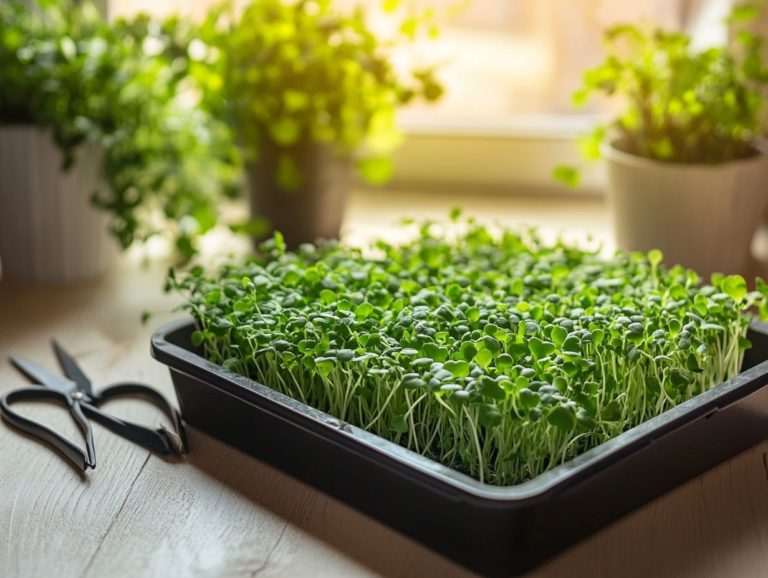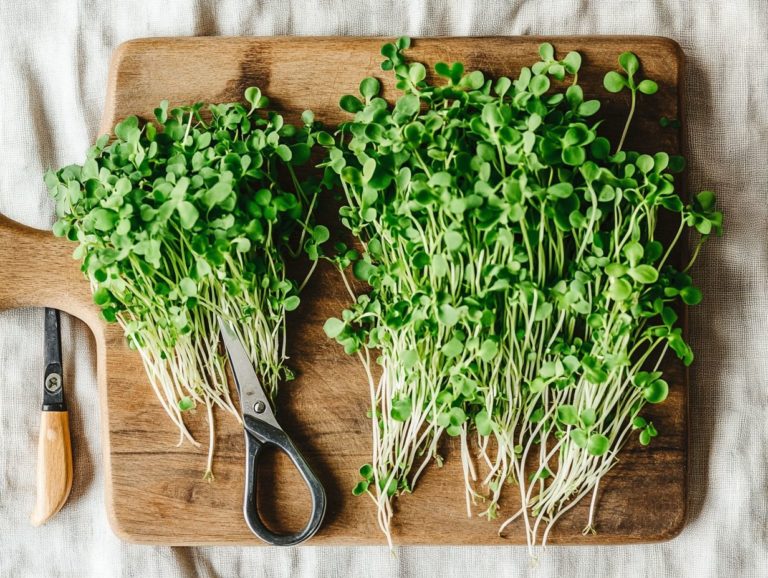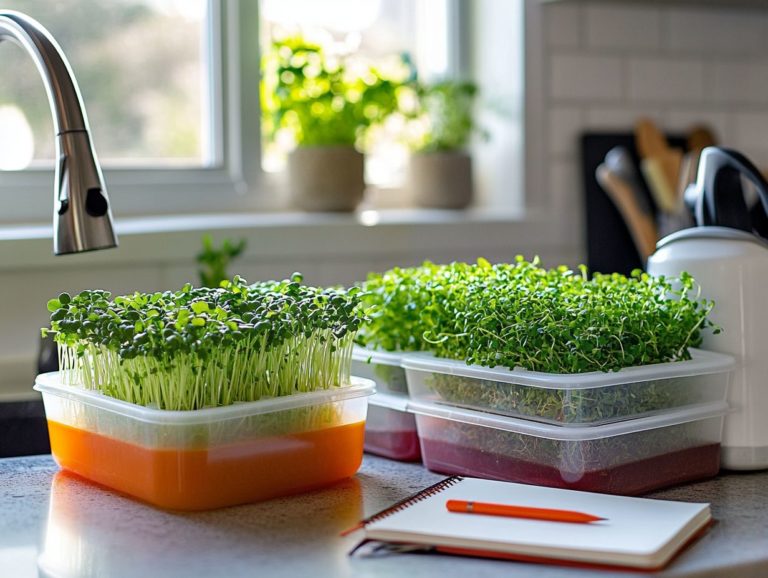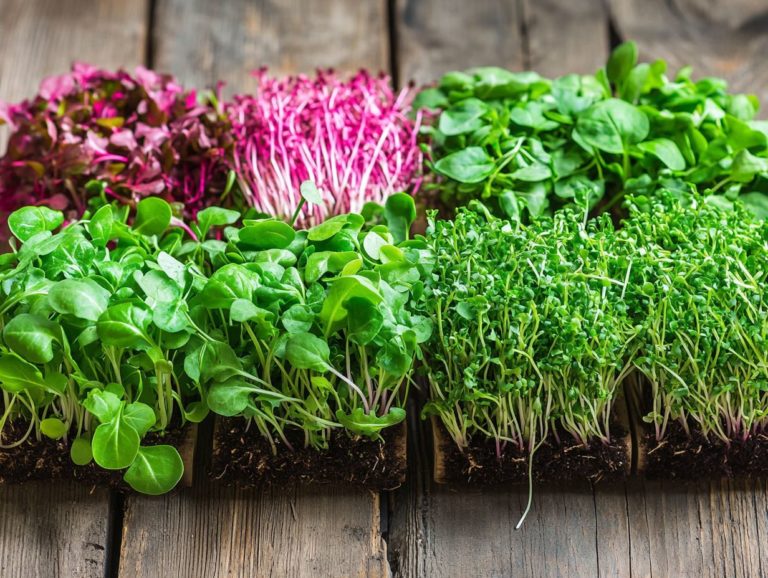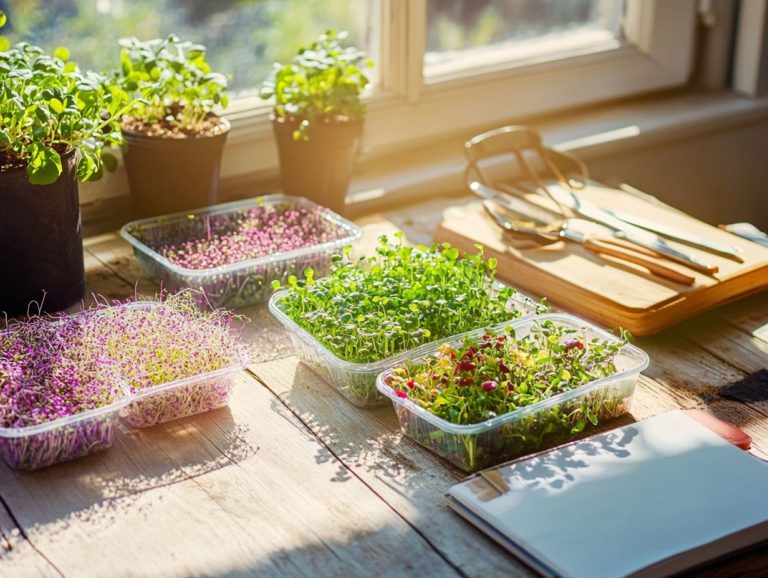Microgreens Storage: Glass vs. Plastic Containers
When it comes to storing microgreens, your choice between glass and plastic containers can significantly influence their freshness and nutritional value.
Each storage option offers distinct benefits and potential drawbacks that every microgreen enthusiast should be aware of. This article outlines the advantages of using both glass and plastic containers, showing how they can help maintain the delicate qualities of your greens.
You ll discover the best practices for optimal storage, ensuring your microgreens remain vibrant and nutritious. Act now to uncover the most effective ways to keep your microgreens at their peak!
Contents
- Key Takeaways:
- Why Proper Storage is Important
- Why Choose Glass Containers?
- Why Opt for Plastic Containers?
- Potential Risks of Using Glass Containers
- Potential Risks of Using Plastic Containers
- Best Practices for Storing Microgreens
- Frequently Asked Questions
- Can I store microgreens in both glass and plastic containers?
- What s the best container for my microgreens?
- What are the benefits of storing microgreens in glass containers?
- Are there any drawbacks to storing microgreens in glass containers?
- How do plastic containers compare to glass containers for microgreens storage?
- Can I use any plastic container for storing microgreens?
Key Takeaways:
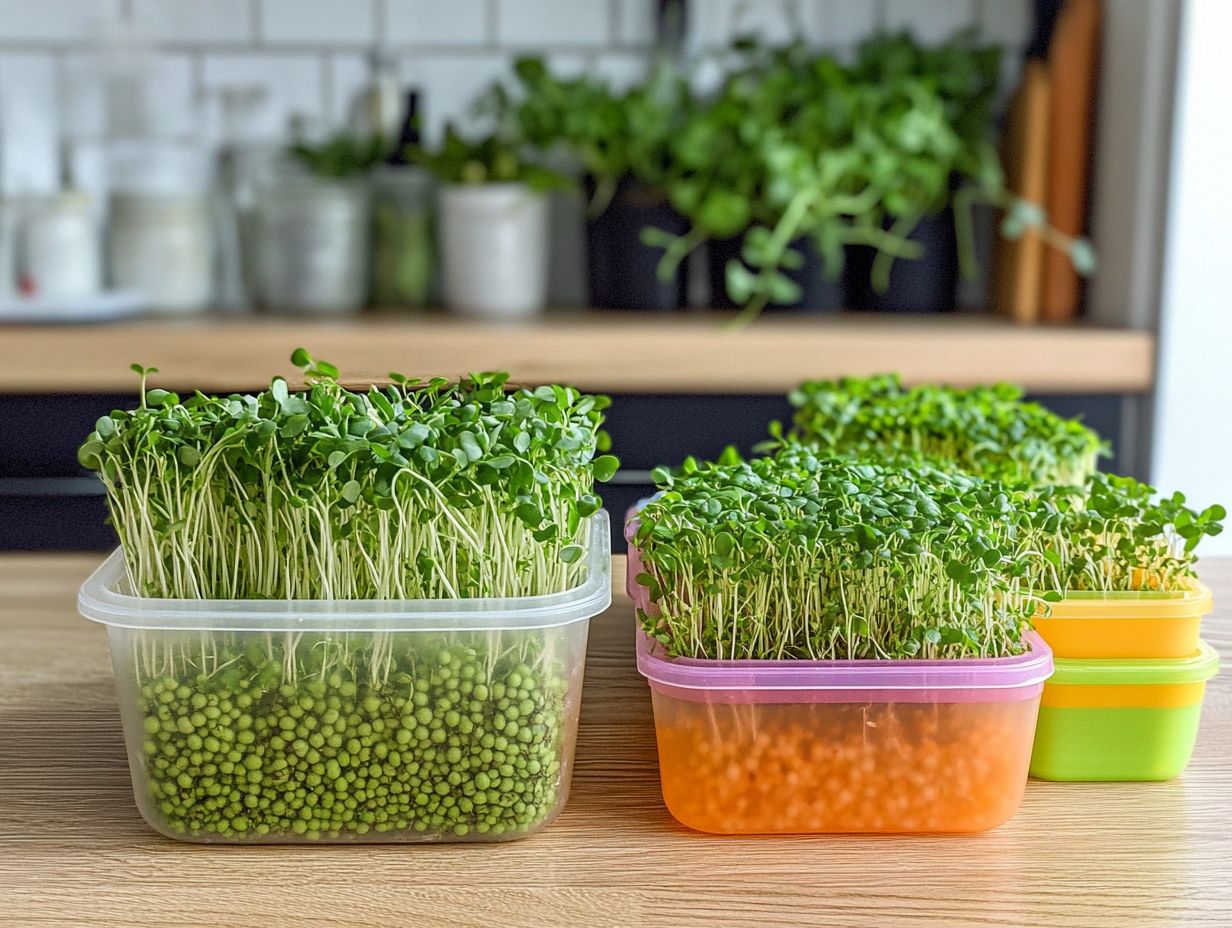
- Glass containers keep microgreens fresh and nutritious perfect for health enthusiasts.
- Plastic containers are budget-friendly and convenient ideal for busy lifestyles.
- Stay informed about risks: glass can break, and plastic may leach chemicals. Follow best practices for safe storage.
Why Proper Storage is Important
Proper food storage is essential for keeping your ingredients fresh and nutritionally intact, safeguarding against foodborne illnesses and minimizing waste.
Using reliable food storage containers can enhance the quality and safety of your meals. With sustainability in mind, choosing eco-friendly containers made from materials safe for food storage allows you to contribute to environmental preservation while ensuring your food remains safe and healthy.
Why Choose Glass Containers?
Glass containers have emerged as the top choice for many, thanks to their impressive range of benefits, including durability and safety for food storage. Unlike plastic, these elegant vessels are microwave safe, freezer safe, and heat resistant, easily enduring a variety of temperatures without compromising food safety.
Their non-porous nature ensures that food remains free from harmful chemicals, making them a perfect option for those who prioritize health and seek reliable food storage solutions.
Preserving Freshness and Nutritional Value
One of the standout features of glass containers is their remarkable ability to preserve the freshness and nutritional value of your food. With airtight seals, these containers minimize exposure to air, preventing spoilage and retaining essential nutrients. This makes them an eco-friendly choice for anyone who values food safety.
By forming a protective barrier against moisture and contaminants, glass containers extend the shelf life of your ingredients, from crisp vegetables to succulent fruits. For those looking to maintain the freshness of delicate items like microgreens, check out storing microgreens: tips for freshness. Unlike plastic alternatives, glass doesn’t leach harmful chemicals, ensuring that your meals remain both safe and delectable. This commitment to sustainability and health makes glass the ideal choice for those who prioritize freshness while wanting to lessen their environmental footprint.
Their durability means you can reuse them countless times, further contributing to waste reduction and promoting a greener lifestyle.
Why Opt for Plastic Containers?
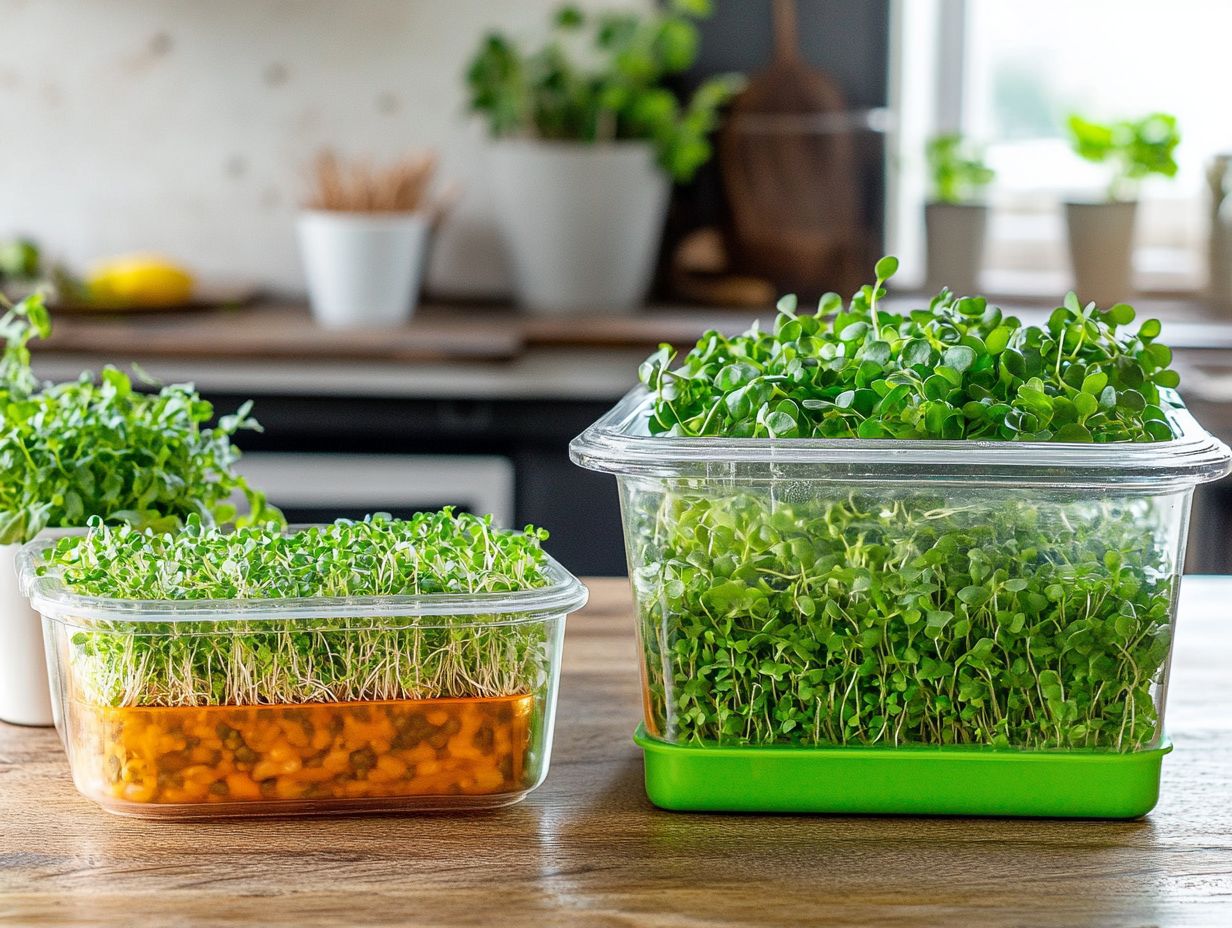
Plastic containers present a multitude of advantages that elevate them as a favored option for food storage, especially considering their convenience and cost-effectiveness.
Crafted for effortless cleaning and efficient storage, these lightweight solutions cater to a wide range of preferences. Many brands now offer BPA-free options, reinforcing safety in food packaging and preparation while addressing contemporary requirements.
In conclusion, whether you choose glass or plastic containers, both offer unique benefits for storing your microgreens. Don t miss out on the chance to keep your greens fresh and tasty experiment with the right container today!
Convenience
Regarding convenience, plastic containers are truly unmatched. They offer you a reliable option for food storage that s hard to surpass.
Their lightweight design means you can handle and transport them with ease.
Additionally, their affordability ensures they fit comfortably within most budgets making them perfect for families and busy individuals alike.
Cost
These versatile storage solutions are available in a wide range of shapes and sizes, accommodating everything from leftovers to lunch preparations. This allows you to organize your kitchen with finesse.
Many plastic containers come equipped with airtight seals, helping to keep your food fresh longer. This ultimately reduces waste and saves you money over time.
Durability
Their durability ensures they can withstand daily use, whether in the microwave, freezer, or the dishwasher, adding to their practicality in your fast-paced lifestyle.
In settings like picnics, meal prepping, or even lunch at the office, the ease of stacking and storing these containers makes them not just a smart choice, but an absolute necessity.
Potential Risks of Using Glass Containers
While glass containers present many benefits, it is crucial for you to recognize the potential risks that accompany their use, such as contamination and breakage.
They are typically safe for food storage. However, improper handling can lead to unfortunate accidents.
Cracks or chips in the glass can undermine its integrity, ultimately posing a health risk.
Possible Contamination and Breakage
Contamination can sneak into your glass containers if you don t follow proper cleaning or storage practices. Breakage is a real concern, especially in bustling kitchens.
Understanding these issues is essential for upholding food safety and preventing accidents that could lead to injury or compromised food quality.
It s important to know that residues left behind can be a breeding ground for bacteria. Therefore, meticulous washing is absolutely vital.
Storing glass containers in high-traffic areas increases the risk of accidental drops, so it’s worth considering where you place them.
Don t wait! Regularly check your glass containers for any chips or cracks and replace any damaged ones without delay.
Using rubberized sleeves can add an extra layer of protection against breakage. Placing containers on stable surfaces and avoiding overcrowding can help prevent accidental tips.
Ultimately, adopting these best practices not only boosts safety but also ensures the integrity of your stored food.
Potential Risks of Using Plastic Containers
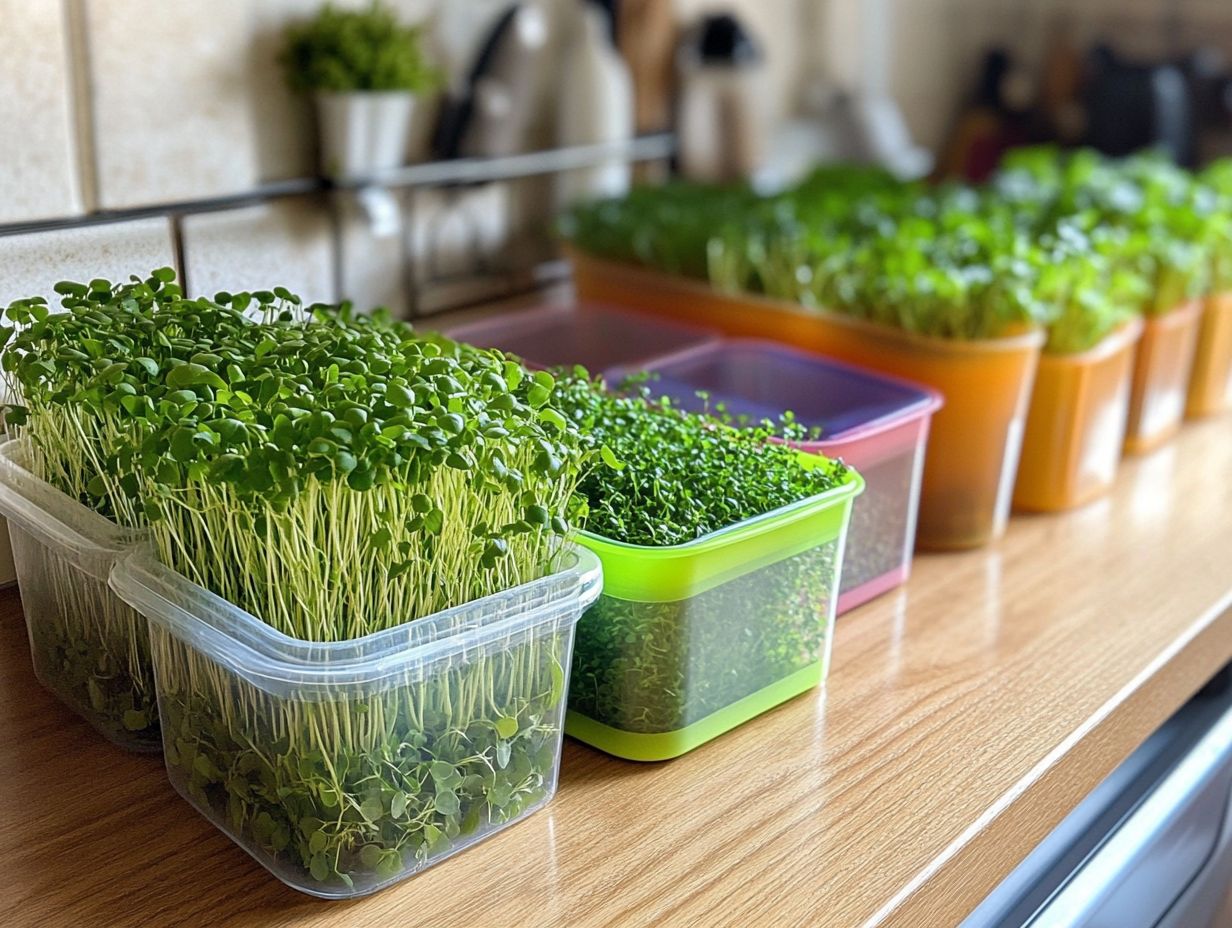
While you may find plastic containers to be a convenient choice for food storage, it s important to be aware of the potential risks involved, especially the leaching of chemicals such as BPA and phthalates into your food.
Understanding these health risks is crucial for anyone who wants to make informed decisions about their food packaging options.
Leaching of Chemicals into Microgreens
The leaching of chemicals into microgreens stored in plastic containers is a matter worth your attention. These delicate plants are particularly susceptible to contamination.
Microgreens flourish in controlled environments, amplifying their vulnerability to harmful substances. Research shows certain plastics can release chemicals like bisphenol A (BPA) and phthalates, which are chemicals found in some plastics that can leach into food.
These compounds not only compromise the taste and quality of these nutrient-packed greens but may also carry long-term health risks for you as the consumer.
As microgreens gain traction in culinary circles and home gardening, it s essential for you to be discerning about storage options.
Opting for food-safe containers made of glass, stainless steel, or certified BPA-free plastic can significantly reduce these risks, ensuring that the vibrant benefits of microgreens grace your table without any compromise.
Best Practices for Storing Microgreens
Storing microgreens correctly is crucial for preserving their freshness and nutritional value. By following best practices, you can significantly extend their shelf life.
Opting for suitable food storage containers, especially eco-friendly ones, not only optimizes the storage environment but also guarantees the safety and quality of these nutrient-rich greens.
Tips for Optimal Storage Conditions
To ensure the best quality of your microgreens, maintain optimal storage conditions using eco-friendly containers. These containers create a balanced environment that significantly enhances the preservation of both taste and nutritional content.
Choosing the right containers protects your microgreens from spoilage and minimizes the risk of contamination, vital for food safety. Opt for airtight options to prevent moisture loss, keeping your greens crisp and vibrant. For the best results, consider the best containers for microgreen cultivation that are lined with soft materials that soak up moisture to regulate humidity levels effectively.
Store your microgreens in a cool, dark place, away from direct sunlight. This further supports their freshness. By adopting the best methods for storing microgreens, you can keep your microgreens at their peak quality, ensuring they are both safe and delicious!
Frequently Asked Questions
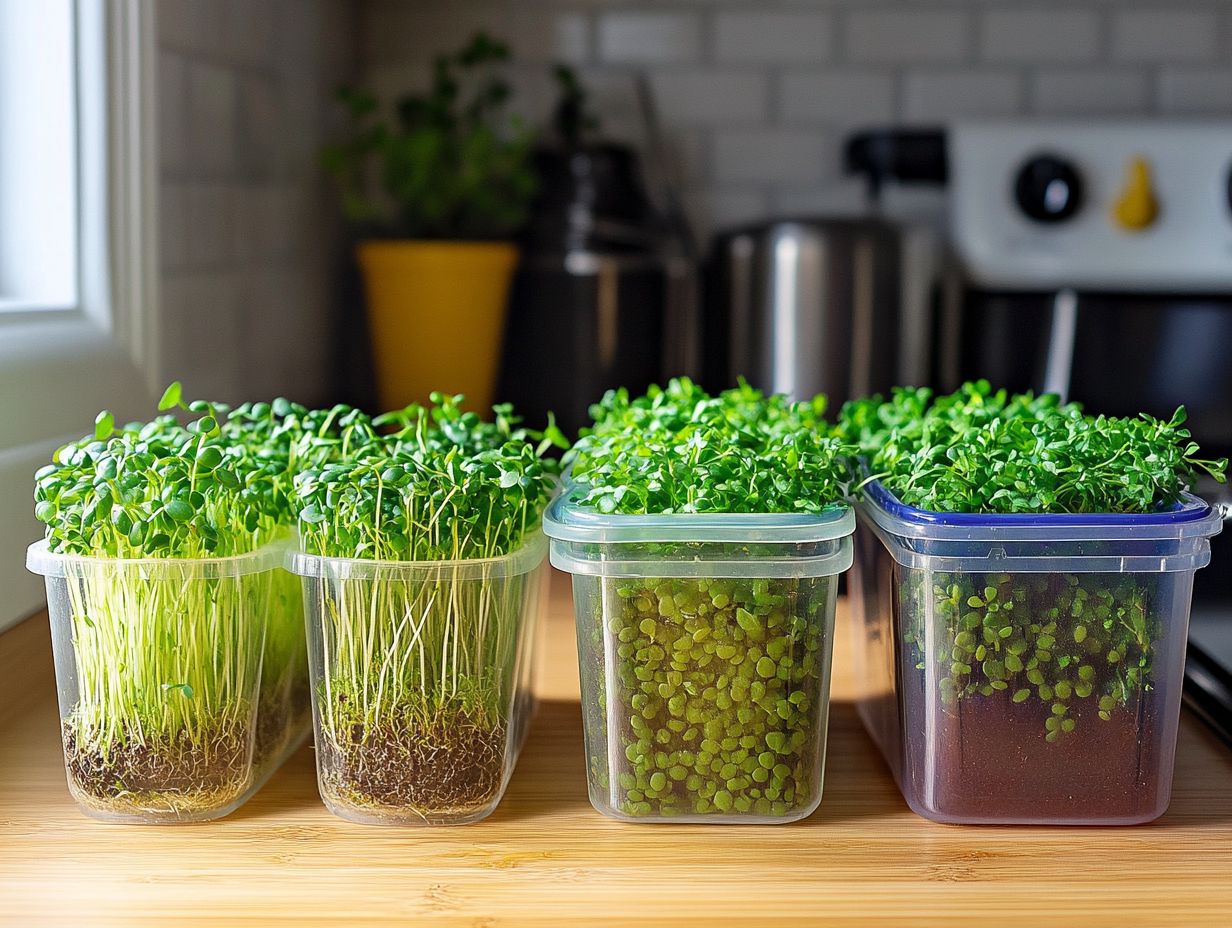
Can I store microgreens in both glass and plastic containers?
Yes, you can store microgreens in both glass and plastic containers. Each type has its benefits and drawbacks.
What s the best container for my microgreens?
It ultimately depends on personal preference and the specific types of microgreens. Both glass and plastic containers provide viable storage options.
What are the benefits of storing microgreens in glass containers?
Glass containers are transparent, allowing you to see the microgreens without opening them. They are also non-toxic and do not leach chemicals into the greens.
Are there any drawbacks to storing microgreens in glass containers?
Glass containers can be more fragile and prone to breakage. They may also be pricier compared to plastic containers.
How do plastic containers compare to glass containers for microgreens storage?
Plastic containers are lighter and less likely to break, making them convenient for storage and transport. However, they may not be as visually appealing as glass containers.
Can I use any plastic container for storing microgreens?
It s best to use food-grade plastic containers for storing microgreens. These are specifically made for food storage and are less likely to leach harmful chemicals.
Start storing your microgreens the right way today and enjoy fresh flavors like never before!

